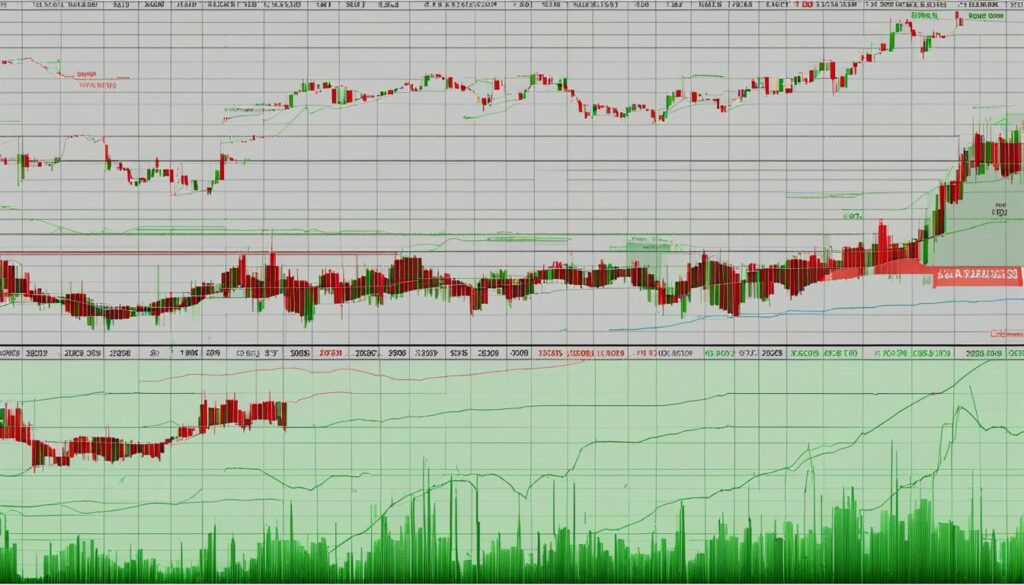Leveraged investing, also known as financial leverage, is a high-risk strategy that involves using borrowed money to seek higher investment profits. This technique introduces additional risk to investors, as the potential returns are dependent on the difference between the investment returns on the borrowed capital and the cost of interest. Understanding the intricacies of leveraged investing is crucial in order to make informed decisions and mitigate potential losses.
There are several common sources of borrowed capital for leveraged investing. These include brokerage margin loans, equity futures contracts, and call options on equities and ETFs. Each source has its own advantages and disadvantages. Knowing the characteristics of these alternatives is essential in determining the right leverage strategy for your portfolio.
Key Takeaways:
- Leveraged investing involves using borrowed money to seek higher investment profits.
- It introduces additional risk to investors.
- Common sources of borrowed capital include margin loans, equity futures contracts, and call options.
- Each source has its own advantages and disadvantages.
- Understanding the risks and rewards is crucial in determining the right leverage strategy.
Types of Borrowed Capital for Leveraged Investing
Leveraged investing allows investors to potentially increase their investment profits by using borrowed money. There are different types of borrowed capital that investors can utilize to implement leverage in their investment strategies. These include margin loans, equity futures contracts, and call options.
Margin Loans
Margin loans are a popular form of borrowed capital for leveraged investing. These loans use the equity in an investor’s account as collateral for the debt. They are regulated by the Securities and Exchange Commission (SEC) to ensure responsible lending practices. Margin loans offer investors a broad selection of investments to leverage, including stocks, bonds, and mutual funds.
When using margin loans, investors must adhere to initial margin and maintenance margin requirements set by the SEC. These requirements determine the maximum leverage ratio an investor can use. Margin loans often come with higher interest rates compared to other types of borrowed capital.
Equity Futures Contracts
Equity futures contracts provide investors with an alternative form of borrowed capital for leveraged investing. These contracts allow investors to purchase specific investments, such as stocks or commodities, at a later date. Equity futures contracts offer higher leverage at lower interest rates compared to margin loans.
The leverage ratio for equity futures contracts varies depending on the underlying asset, ranging from 5 to 1 to 20 to 1. These contracts provide investors with the opportunity to amplify potential returns. However, they also expose investors to the risk of significant losses if the price of the underlying security declines.
Call Options
Call options are another type of borrowed capital that investors can use for leveraged investing. These options give investors the right to buy a security at a specific price during a specified period. Call options offer leverage through their contractual terms and can be used to limit downside risk.
The selection of the appropriate call option involves considering factors such as the strike price, expiration date, and premium. Call options provide potential for higher overall returns but also introduce complexity and risks that investors must carefully consider.
| Type of Borrowed Capital | Advantages | Disadvantages |
|---|---|---|
| Margin Loans | Offers a broad selection of investments | Higher interest rates |
| Equity Futures Contracts | Higher leverage at lower interest rates | Risk of significant losses |
| Call Options | Potential for higher overall returns, limited downside risk | Complexity and risks to consider |
Margin Loans for Leveraged Investing
Margin loans are a popular choice for investors looking to leverage their investments. These loans utilize the equity in an investor’s account as collateral, allowing them to borrow funds to increase their buying power. However, it’s important for investors to understand the risks and benefits associated with margin loans before utilizing this form of leverage.
Initial Margin and Maintenance Margin
When using margin loans, investors must adhere to the initial margin and maintenance margin requirements set by the Securities and Exchange Commission (SEC). These requirements dictate the maximum leverage ratio a investor can utilize. The initial margin is the amount of equity an investor must have in their account to initiate a margin loan, while the maintenance margin is the minimum amount of equity required to maintain the loan.
For example, if the initial margin requirement is set at 50%, an investor must have at least 50% of the total investment value in their account before borrowing funds through a margin loan. If the maintenance margin requirement is set at 30%, the investor must maintain at least 30% equity in their account to avoid a margin call, which occurs when the equity falls below the specified threshold.
Interest Rates
One consideration when using margin loans is the interest rate. Margin loans typically come with higher interest rates compared to other forms of borrowing. These rates are tiered based on the loan balance, with higher balances often qualifying for lower interest rates. It’s crucial for investors to assess the interest rates associated with margin loans and determine if the potential returns outweigh the cost of borrowing.
| Loan Balance | Interest Rate |
|---|---|
| $0 – $25,000 | 8% |
| $25,001 – $50,000 | 7.5% |
| $50,001 – $100,000 | 7% |
| Above $100,000 | 6.5% |
Investors should carefully consider their risk tolerance, investment goals, and expected returns before using margin loans. While they offer the potential for increased buying power, the risks associated with margin calls and high interest rates must be weighed against the potential rewards.
Equity Futures Contracts for Leveraged Investing
Equity futures contracts are a popular choice for leveraged investing due to their ability to provide higher leverage at lower interest rates compared to margin loans. These contracts allow investors to purchase specific investments at a later date and are often associated with currencies, commodities, and interest-earning instruments.
In recent years, equity futures trading has become more accessible to retail investors, with leverage ratios ranging from 5 to 1 to 20 to 1, depending on the underlying asset. This means that investors can control a larger investment position with a smaller initial capital outlay.
| Leveraged Instrument | Leverage Ratio | Interest Costs |
|---|---|---|
| Equity Futures Contracts | 5:1 to 20:1 | Broker call rate – Dividend yield |
One of the key advantages of equity futures contracts is their potential for higher capital efficiency. By allowing investors to control a larger investment position with less capital, futures contracts can magnify potential profits.
However, it’s important to note that equity futures contracts also come with their own set of risks. If the price of the underlying security declines, investors can face significant losses. Therefore, it is crucial for investors to carefully consider their risk tolerance and market conditions before engaging in leveraged investing with equity futures contracts.

Risk and Reward Comparison:
- Reward: Equity futures contracts offer higher leverage ratios compared to other leveraged instruments.
- Risk: Equity futures contracts expose investors to the potential for significant losses if the price of the underlying security declines.
- Risk: Interest costs for futures contracts are calculated based on the broker call rate minus the dividend yield paid by the underlying securities.
Call Options for Leveraged Investing
Call options are a popular choice for leveraged investing as they provide investors with the right to buy a security at a specific price, known as the strike price, on or before a specified future date, known as the expiration date. This contractual agreement allows investors to leverage their capital and potentially generate higher returns.
One of the key factors to consider when trading call options is the premium, which is the price paid for the option contract. The premium is determined by various factors, including the underlying security’s volatility and the time remaining until expiration. It is important for investors to carefully analyze these factors to determine whether the premium represents a fair value for the leverage provided.
Call options offer the advantage of limiting downside risk. If the market price of the underlying security falls below the strike price, investors are not obligated to exercise the option and can simply let it expire. This provides a level of protection against significant losses, making call options an attractive tool for those looking to manage risk while still seeking potential returns.
Example Table: Comparison of Call Options
| Option | Strike Price | Expiration Date | Premium |
|---|---|---|---|
| Option A | $50 | 30 days | $2.50 |
| Option B | $55 | 60 days | $3.00 |
| Option C | $60 | 90 days | $3.50 |
“Call options provide the potential for higher overall returns while allowing investors to limit downside risk. However, it’s crucial for investors to carefully analyze the premium and strike price in relation to the expected price movement of the underlying security.”
Overall, call options are a valuable tool in leveraged investing as they offer the potential for higher returns and downside risk management. Investors must thoroughly analyze the premium, strike price, and expiration date to make informed decisions and take advantage of the leverage provided by call options.

Leveraged Instruments: Comparing Margin Loans, Equity Futures Contracts, and Call Options
When it comes to leveraged investing, there are different instruments that investors can choose from to amplify their potential returns. Each instrument comes with its own advantages, disadvantages, leverage ratios, interest rates, and risk exposures. Understanding the differences between these leveraged instruments is crucial in making informed decisions that align with your investment goals and risk tolerance. In this section, we will compare three common leveraged instruments: margin loans, equity futures contracts, and call options.
Margin Loans
Margin loans are widely available and easy to use for leveraged investing. They use the equity in an investor’s account as collateral for the debt, allowing investors to purchase additional securities. Margin loans offer a broad selection of investments, including stocks, bonds, and mutual funds. However, they also expose investors to significant financial risk. If the equity in the account falls below a predetermined level, known as the maintenance margin, investors may be required to add additional funds or securities to meet the margin requirements. Failure to do so could result in the forced sale of securities to cover the debt. Additionally, margin loans come with comparatively high interest rates that are tiered based on the loan balance.
Equity Futures Contracts
Equity futures contracts provide investors with the ability to purchase specific investments at a later date. These contracts offer higher leverage at lower interest rates compared to margin loans. They are often associated with currencies, commodities, and interest-earning instruments. However, equity futures contracts are not available to all investors and have limited investment selection compared to margin loans. The leverage ratio for equity futures contracts ranges from 5 to 1 to 20 to 1, depending on the underlying asset. Investors should also note that futures contracts expose them to the risk of significant losses if the price of the underlying security declines.
Call Options
Call options give investors the right to buy a security at a specific price on or before a specified future date. They provide leverage through their contractual terms and can be used to limit downside risk. Call options are particularly useful in volatile markets, as they allow investors to benefit from potential price increases while limiting their losses if the price declines. However, selecting the appropriate call option can be challenging. Investors need to consider factors such as the strike price, expiration date, and premium, as these determine the cost and leverage provided by the option.
In summary, leveraged instruments like margin loans, equity futures contracts, and call options offer different strategies for investors looking to amplify their potential returns. Margin loans provide a broad selection of investments but expose investors to significant financial risk. Equity futures contracts offer higher leverage at lower interest rates but have limited investment selection. Call options combine leverage and hedging to limit downside risk but require careful consideration when selecting the appropriate option. By understanding the advantages, disadvantages, and risk exposures of these leveraged instruments, investors can make informed decisions that align with their investment goals and risk tolerance.

Risks and Benefits of Leveraged Investing
Leveraged investing offers the potential for higher investment returns but also comes with significant risks. It is important for investors to understand the benefits and risks of leveraging and have a clear investment strategy in place before using leverage. Considering factors such as risk tolerance, market conditions, and liquidity is crucial in determining the right leverage strategy.
One of the key benefits of leveraged investing is the potential for higher returns. By using borrowed money, investors can amplify their investment gains if the investments perform well. This can be especially appealing for investors looking to grow their wealth quickly or take advantage of market opportunities. However, it’s important to note that potential returns can vary significantly depending on the performance of the investments and the cost of interest.
On the downside, leveraged investing also exposes investors to potential losses. When using borrowed money, investors not only have to pay back the original amount borrowed but also the interest costs associated with the loan. If the investments perform poorly, the losses can be magnified, and investors may find themselves in a situation where they owe more than the value of their investments. This is why it is crucial for investors to have a thorough understanding of their risk tolerance and the potential risks involved in leveraged investing.
| Benefits of Leveraged Investing | Risks of Leveraged Investing |
|---|---|
| • Potential for higher investment returns | • Exposure to potential losses |
| • Opportunity to grow wealth quickly | • Magnification of investment losses |
| • Ability to take advantage of market opportunities | • Increased financial risk |
In summary, leveraged investing can be a powerful tool for investors looking to potentially increase their investment returns. However, it is essential to carefully consider the risks and benefits involved, as well as personal risk tolerance. Having a clear investment strategy and understanding the complexities of leverage can help investors navigate the world of leveraged investments with a higher chance of success.
Conclusion
Leveraged investing can be a powerful strategy for increasing investment returns, but it comes with significant risks. Understanding the benefits and risks of leveraging is crucial for investors to make informed decisions and achieve long-term success. By carefully considering factors such as risk tolerance, market conditions, and liquidity, investors can determine the right leverage strategy for their individual goals.
It is important to note that leveraged investing involves borrowing money to invest, which magnifies both potential gains and losses. While it offers the potential for higher returns, investors must also be prepared for the possibility of significant losses. Proper risk management and a clear investment strategy are essential for navigating the complexities of leveraged investments.
By maintaining a thorough understanding of the risks and rewards associated with leveraged investing, investors can make informed decisions and increase their chances of success. Leveraged investing can be a valuable tool for achieving investment goals, but it requires careful consideration, diligent research, and ongoing monitoring to ensure that the strategy aligns with individual risk tolerance and market conditions.
FAQ
What is leveraged investing?
Leveraged investing is a technique that seeks higher investment profits by using borrowed money.
What are the sources of borrowed capital for leveraged investing?
Common sources of borrowed capital include brokerage margin loans, equity futures contracts, and call options on equities and ETFs.
How do margin loans work?
Margin loans use the equity in an investor’s account as collateral for the debt. They are regulated by the Federal Reserve and other agencies to prevent the excessive extension of credit.
What are the advantages and disadvantages of margin loans?
Margin loans provide a broad selection of investments but expose investors to significant financial risk if the equity in the account falls below a predetermined level.
How do equity futures contracts differ from margin loans?
Equity futures contracts are financial instruments used to purchase specific investments at a later date and offer higher leverage at lower interest rates compared to margin loans.
What risks are associated with equity futures contracts?
While futures contracts provide opportunities for higher capital efficiency and profit potential, they also expose investors to the risk of significant losses if the price of the underlying security declines.
How do call options work?
Call options give investors the right to buy a security at a specific price on or before a specified future date. They provide leverage through their contractual terms and can be used to limit downside risk.
What factors should investors consider when choosing leveraged instruments?
Investors should consider the advantages, disadvantages, leverage ratios, interest rates, and risk exposures of different leveraged instruments before making a decision.
What risks are associated with leveraged investing?
Leveraged investing comes with significant risks, as the difference between investment returns and the cost of interest can magnify both potential gains and losses. Proper risk management is essential.
How can investors navigate leveraged investing successfully?
By understanding the benefits and risks of leverage, having a clear investment strategy, considering risk tolerance and market conditions, and properly managing risk, investors can increase their chances of success in leveraged investing.
Are Money Market Funds Considered Safe Investments in Leveraged Investing?
Are money market funds considered safe investments in leveraged investing? When it comes to investing in money market funds, many people consider them to be relatively safe. These funds typically invest in low-risk securities, such as government bonds and high-quality commercial paper. However, it’s important to note that even though money market funds aim to maintain a stable net asset value (NAV), they are not entirely risk-free. Economic downturns or any disruption in the market can impact their stability. Therefore, investors should thoroughly assess their risk tolerance and investment goals before investing in money market funds.


Pingback: High-Yield Bonds: Navigating the Risks and Rewards of Junk Bonds – Straight Fire Money